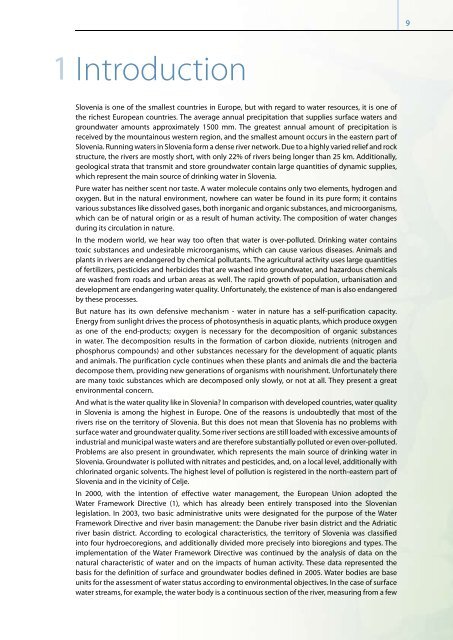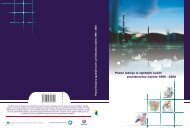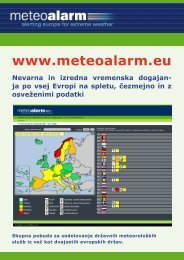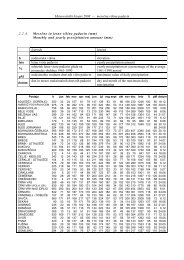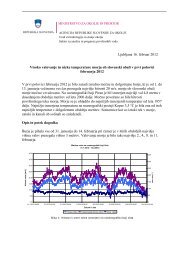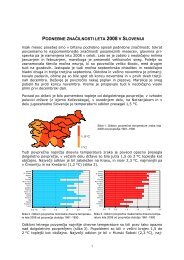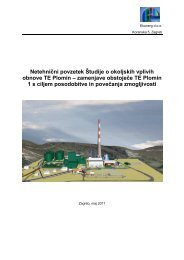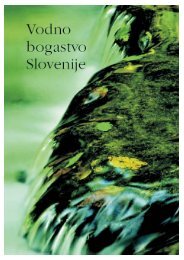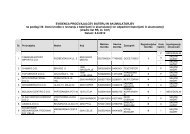Water Quality in Slovenia - Agencija RS za okolje
Water Quality in Slovenia - Agencija RS za okolje
Water Quality in Slovenia - Agencija RS za okolje
You also want an ePaper? Increase the reach of your titles
YUMPU automatically turns print PDFs into web optimized ePapers that Google loves.
1<br />
Introduction<br />
<strong>Slovenia</strong> is one of the smallest countries <strong>in</strong> Europe, but with regard to water resources, it is one of<br />
the richest European countries. The average annual precipitation that supplies surface waters and<br />
groundwater amounts approximately 1500 mm. The greatest annual amount of precipitation is<br />
received by the mounta<strong>in</strong>ous western region, and the smallest amount occurs <strong>in</strong> the eastern part of<br />
<strong>Slovenia</strong>. Runn<strong>in</strong>g waters <strong>in</strong> <strong>Slovenia</strong> form a dense river network. Due to a highly varied relief and rock<br />
structure, the rivers are mostly short, with only 22% of rivers be<strong>in</strong>g longer than 25 km. Additionally,<br />
geological strata that transmit and store groundwater conta<strong>in</strong> large quantities of dynamic supplies,<br />
which represent the ma<strong>in</strong> source of dr<strong>in</strong>k<strong>in</strong>g water <strong>in</strong> <strong>Slovenia</strong>.<br />
Pure water has neither scent nor taste. A water molecule conta<strong>in</strong>s only two elements, hydrogen and<br />
oxygen. But <strong>in</strong> the natural environment, nowhere can water be found <strong>in</strong> its pure form; it conta<strong>in</strong>s<br />
various substances like dissolved gases, both <strong>in</strong>organic and organic substances, and microorganisms,<br />
which can be of natural orig<strong>in</strong> or as a result of human activity. The composition of water changes<br />
dur<strong>in</strong>g its circulation <strong>in</strong> nature.<br />
In the modern world, we hear way too often that water is over-polluted. Dr<strong>in</strong>k<strong>in</strong>g water conta<strong>in</strong>s<br />
toxic substances and undesirable microorganisms, which can cause various diseases. Animals and<br />
plants <strong>in</strong> rivers are endangered by chemical pollutants. The agricultural activity uses large quantities<br />
of fertilizers, pesticides and herbicides that are washed <strong>in</strong>to groundwater, and ha<strong>za</strong>rdous chemicals<br />
are washed from roads and urban areas as well. The rapid growth of population, urbanisation and<br />
development are endanger<strong>in</strong>g water quality. Unfortunately, the existence of man is also endangered<br />
by these processes.<br />
But nature has its own defensive mechanism - water <strong>in</strong> nature has a self-purification capacity.<br />
Energy from sunlight drives the process of photosynthesis <strong>in</strong> aquatic plants, which produce oxygen<br />
as one of the end-products; oxygen is necessary for the decomposition of organic substances<br />
<strong>in</strong> water. The decomposition results <strong>in</strong> the formation of carbon dioxide, nutrients (nitrogen and<br />
phosphorus compounds) and other substances necessary for the development of aquatic plants<br />
and animals. The purification cycle cont<strong>in</strong>ues when these plants and animals die and the bacteria<br />
decompose them, provid<strong>in</strong>g new generations of organisms with nourishment. Unfortunately there<br />
are many toxic substances which are decomposed only slowly, or not at all. They present a great<br />
environmental concern.<br />
And what is the water quality like <strong>in</strong> <strong>Slovenia</strong>? In comparison with developed countries, water quality<br />
<strong>in</strong> <strong>Slovenia</strong> is among the highest <strong>in</strong> Europe. One of the reasons is undoubtedly that most of the<br />
rivers rise on the territory of <strong>Slovenia</strong>. But this does not mean that <strong>Slovenia</strong> has no problems with<br />
surface water and groundwater quality. Some river sections are still loaded with excessive amounts of<br />
<strong>in</strong>dustrial and municipal waste waters and are therefore substantially polluted or even over-polluted.<br />
Problems are also present <strong>in</strong> groundwater, which represents the ma<strong>in</strong> source of dr<strong>in</strong>k<strong>in</strong>g water <strong>in</strong><br />
<strong>Slovenia</strong>. Groundwater is polluted with nitrates and pesticides, and, on a local level, additionally with<br />
chlor<strong>in</strong>ated organic solvents. The highest level of pollution is registered <strong>in</strong> the north-eastern part of<br />
<strong>Slovenia</strong> and <strong>in</strong> the vic<strong>in</strong>ity of Celje.<br />
In 2000, with the <strong>in</strong>tention of effective water management, the European Union adopted the<br />
<strong>Water</strong> Framework Directive (1), which has already been entirely transposed <strong>in</strong>to the <strong>Slovenia</strong>n<br />
legislation. In 2003, two basic adm<strong>in</strong>istrative units were designated for the purpose of the <strong>Water</strong><br />
Framework Directive and river bas<strong>in</strong> management: the Danube river bas<strong>in</strong> district and the Adriatic<br />
river bas<strong>in</strong> district. Accord<strong>in</strong>g to ecological characteristics, the territory of <strong>Slovenia</strong> was classified<br />
<strong>in</strong>to four hydroecoregions, and additionally divided more precisely <strong>in</strong>to bioregions and types. The<br />
implementation of the <strong>Water</strong> Framework Directive was cont<strong>in</strong>ued by the analysis of data on the<br />
natural characteristic of water and on the impacts of human activity. These data represented the<br />
basis for the def<strong>in</strong>ition of surface and groundwater bodies def<strong>in</strong>ed <strong>in</strong> 2005. <strong>Water</strong> bodies are base<br />
units for the assessment of water status accord<strong>in</strong>g to environmental objectives. In the case of surface<br />
water streams, for example, the water body is a cont<strong>in</strong>uous section of the river, measur<strong>in</strong>g from a few<br />
9


